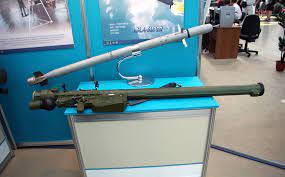CURRENT AFFAIRS
Get the most updated and recent current affair content on Padhaikaro.com
Igla-S VSHORAD DEAL
- Vaid's ICS, Lucknow
- 28, Feb 2022

Indian Army has picked Russia’s Igla-S missile system as choice for its multibillion dollar contract for man-portable air defence systems (MANPADS). Igla-S bid around $1.47 billion from Russia’s Rosoboronexport had emerged lowest bidder for Indian Army’s Very Short Range Air Defence (VSHORAD) deal.
The other bidders were MBDA of France (bid of $3.68 billion) and SAAB of Sweden (bid of $2.6 billion).
The deal is expected to be inked when Indian-Russian Intergovernmental Commission on Military-Technical cooperation meeting will take place in Moscow in December 2018.
- Igla-S” is a man-portable surface-to-air missile system.
- Igla-S constitutes a short range air defence system.
- This type of air defense system is designed to defeat all types of visible fixed- and rotary-winged aircraft on head-on and in pursuit courses as well as small aerial targets like cruise missiles.
- The Indian Army had contracted a small number of Igla-S systems from Russia under emergency procurement through the Vice-Chiefs emergency financial powers and deliveries are expected soon.
IGLA-S (SA-24)
It is latest model of Russian MANPADS (Man-portable air-defense system) technology.
- It offers superior performance over earlier supplied SA-18 missiles to India.
- It is designed for use against visible aerial targets at short range such as tactical aircraft, helicopters, unmanned aerial vehicle (UAVs), cruise missile, head-on or receding, in presence of natural (background) clutter and countermeasures.
- As per requirements of Indian Army, it will have maximum range of 6km, altitude of 3km along with all-weather capability.
- Igla-S missile system will replace the existing Igla in service which is in urgent need of replacement.
FACTS FOR PRELIMS
996 culture:
- The 996 working hour system is a work schedule practiced by some companies in the People’s Republic of China.
- It derives its name from its requirement that employees work from 9:00 am to 9:00 pm, 6 days per week; i.e. 72 hours per week.
‘Net Minus’ paradigm:
- In the run up to the upcoming U.N. Climate Change Conference (COP26) in Glasgow, India has come under pressure, especially from the U.S. and U.K, to announce more ambitious emission cuts, beyond what came out of its Paris commitments and to provide a deadline by which it will reach ‘Net Zero’’ emissions.
- India’s line of argument has been that developing countries need space to grow and developed countries must move to a ‘Net Minus’ paradigm and meet climate finance obligations first.
- ‘Net Minus’ paradigm calls for Carbon Dioxide Removal (CDR). As it is the opposite of emissions, these practices or technologies are often described as achieving “negative emissions” or “sinks”.
- Indian Finance Minister who is on a U.S. visit has repeatedly raised or discussed the issue of climate finance obligations and technology transfer from the developed countries.
- Developed countries have committed under the Paris Agreement to allocate $100 billion per year from 2020 onwards to facilitate emission cuts in poorer countries and also to effect technology transfer.